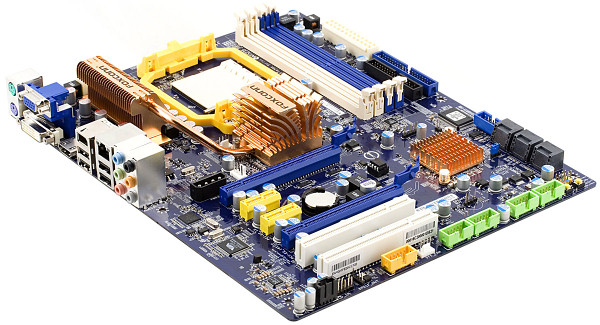Foxconn A7DA-S Motherboard
|
As we have already found out in our tests of AMD 790GX, this chipset can be used in motherboards aimed at two large groups of users. Firstly, those willing to build a generic PC with an integrated graphics core (provided this graphics core is powerful enough, of course; 790GX meets this requirement to the full). Secondly, those willing an expandable, but inexpensive motherboard for a powerful gaming computer, possibly even with CrossFire (which is getting increasingly popular, considering not only chipset characteristics, but also higher attractiveness of RADEON-based graphics cards in all market segments).
However, we cannot say that this motherboard is aimed strictly to the either group. Its graphics core is equipped with the fastest video buffer, which should please those users, who don't want to install an external graphics card. Solid power circuits and developed overclocking options apparently hint at a powerful gaming potential.


We don't have even a theoretical gripe with the design: the motherboard can easily accommodate two graphics cards of any dimensions existing in the Radeon series, and they won't interfere with any other components. Power connectors reside at the edge of the board, the floppy connector is also placed conveniently. But if you want a COM port on the rear panel, you will have to find a bracket with a long cable. We are glad to see bordered connectors for USB and FireWire ports. That's an apparent progress - several years ago inexpensive motherboards were outfitted with even borderless SATA ports (no wonder, many users complained about RAID arrays breaking up even after short relocations). Now SATA ports, especially popular 'horizontal' ones, can hold plugs securely. And some manufacturers, for example Gigabyte, include cables with latches into their bundles to prevent spontaneous disconnections of hard drives (this very motherboard comes with regular cables, though).

The cooling system also has a very good design. It's probably the most rational design among excessive systems with heat pipes: heatsinks on the Northbridge and field-effect transistors in the voltage regulator of the chipset are interconnected and arranged so that any CPU cooler will blow at at least one heatsink. Only the contact between the heatsink and field-effect transistors is not very tight (imprints of the outermost chips on thermal grease were not very distinct). However, it's not a problem in itself, only a natural property of retention with plastic latches. It's especially noticeable in comparison with rare a retention method: when a heatsink is screwed to the metal plate on the back side of the board.
 |
 |
Should we say that these large heatsinks remain barely warm or stay at the environment temperature with the nominal CPU and GPU frequencies regardless of the load? However, Foxconn positions this motherboard as a relatively expensive model. The company provides a rich set of BIOS options. Taking into account that even Phenom X4 9850 comes with a very attractive price tag these days, users of this motherboard may install a powerful processor and want to try its overclocking (with an overclocked graphics core at that). In this case the enhanced cooling capacity may come in handy to provide comfortable operating conditions for the CPU voltage regulator in the first place. And successful overclocking directly depends on stability of power supply. Hynix H5TQ1G63AFP-H9C video memory chips (128 MB DDR3-1333) are not covered with a heatsink. There is no need to do it, because the motherboard does not allow to overclock video memory, and they do not grow very hot in their nominal mode.

The 5-phase switching voltage regulator of the processor incorporates three field-effect transistors per channel in four channels responsible for supplying power to processor cores. The fifth channel, responsible for the memory controller and HT bus, comes with two transistors. The power circuit also contains 9 x 560 uF and 4 x 270 uF solid capacitors. There are no empty seats on this motherboard. Foxconn also offers another model on the same chipset (A7DA) without a video buffer and FireWire controller. Motherboard dimensions -- 305x245 mm (standard ATX), nine-screw mount, all corners are firmly fixed.
Write a comment below. No registration needed!
|
|
 |
|
|
|


